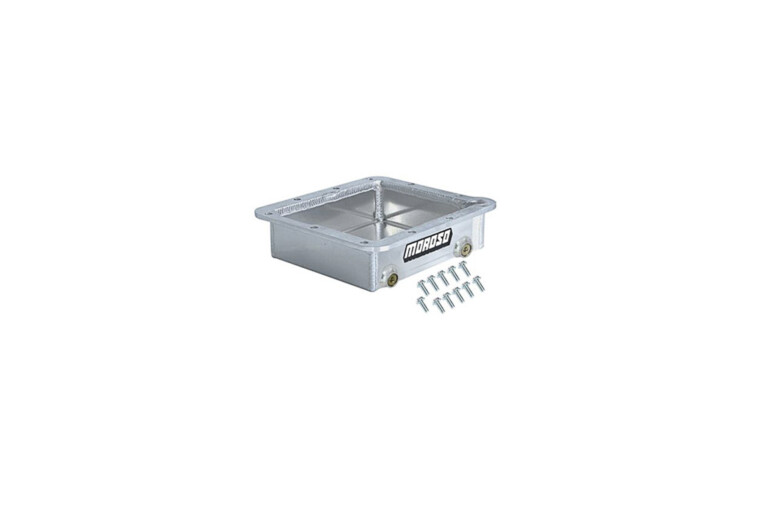You sit in the stands, anxiously awaiting the arrival of the next pair of performance monsters to line up at the tree. Burnt rubber and high octane racing fuel permeate the air at the drag strip, as the two cars produce billowing clouds of white smoke that only seconds before were expensive slicks. They line up and rev the engines, and even from 100 yards away you can feel the bone rattling, ground shaking, and eardrum bursting roar of the 1,000 horsepower engines.
This symphony of mechanical synchronization is the result of headers built to perform in the upper echelons of the racing world. But the use of large racing headers can produce problems all their own, especially on stock chassis and engine vehicles. Potential problems range from fitment to ground clearance issues, and they may even make the simplest tasks such as changing spark plugs a major problem.
This is the issue facing Project Grandma. The need for good fitting race headers.
A 1978 Malibu, former V6 Sunday driver, is in the process of being converted to an Edelbrock 555ci powered big block crate engine, backed by a TCI Glide that will help this old lady really boogey down the block. However, because this G-body was never meant to house anything more than a 350, clearance issues with the headers became readily apparent.
Enter Dan Lemons and his custom made to order headers – Lemon’s Headers.
|
|
History of Lemons Headers
Dan was a cabinet maker in Paso Robles, CA who had worked for Hooker Headers in the late 60’s and early 70’s. Some local guys who knew him from his work with Hooker approached Dan and asked him to make them custom headers. His passion for headers was rekindled, and on a whim he placed an advertisement in National Dragster offering custom header work.
His first customer was a fellow from Georgia, who wanted a big tube size for his early model Camaro (which Dan later bought and still has). The customer was very excited about Dan’s work, and convinced him that he should be doing this full time. Within a week, he had ten more orders for his large diameter Camaro headers. He set off with no business plan, but in Dan’s words, “this isn’t rocket science.” Thus, Lemons Headers was born.
Dan now has four employees and an extensive product list of custom headers for a wide variety of vehicles spanning several generations, ranging from early and late model Camaros, to big block Chevy’s, to swapped Fox body Mustangs. Dan doesn’t keep any headers in stock – each set is made to order.
Grandma’s big inch Edelbrock 555 leaves little room between the frame rails and the engine, so off-the-shelf headers were a no-go. Smaller diameter headers would choke the 555, which has been built to produce 1,000 nitrous injected horsepower. We turned to Dan Lemons, who sent us a set of stainless steel, five piece headers specifically built for the G-Body Malibu.
The Lemon’s G-Body Race header were custom made for our application, but they are available with a variety of options:
- Any tubing size up to 2.5-inches
- Any collector size up to 5.0-inches
- Collector Muffler up to 6.0-inches!
It works with stock small block frame stands or the Moroso mount mounts, and of course, you can use it with a motor plate! It is intended for use with skinny drag racing type tires on the front for maximum clearance with the tubes around the frame. According to Lemon’s, “We hold the headers and collectors up as high as possible for ground clearance. If you will be using a large exhaust system you may have to notch the driver side transmission cross member for additional exhaust room.”
We did a dry install to give you an idea of what fender well headers look like.

Grandma, in all her unfinished glory. Ready for Headers!
You might be asking yourself, what the heck is a fender well header? Quite simply, it is a massive header that typically has tubes that run outside of the frame rails. The headers for Grandma consists of 2 ¼ inch primaries that fit into a 4-inch collector, which pass through the inner fender well, over the frame rail, and then under the car.
Lemons Headers do not come pre-assembled, because if they did it would be impossible to fit the frame rail between them. Each primary is installed separately and runs into a 4-inch massive coned collector at the bottom, which will eventually be hooked up to a Flowmaster 4-inch exhaust so you won’t need a hearing aid by the time you leave the track. Well, even though they will be loud, we’ll at least “pretend” that they quiet the car!
The really glorious thing about these headers is that they provide plenty of ground clearance and room for pulling spark plugs, even in the most cramped engine bay. While they do require you to ditch your inner fenders – we were going to do it anyways. Plus, chances are that if you need headers of this size for an engine the size of Grandma’s, your only concern will be going in a straight line as fast as you can.
Lemons Headers aren’t only about providing you room to work on your engine, they’ve also incorporated plenty of performance features. The headers that we got for Grandma are stepped headers, meaning the primary goes from a 2-1/8 inch tube to 2.25-inches. According to Dan Lemon’s, the step header will provide better scavenging than a straight tube header, broadening the torque curve. When you order your headers from Lemon’s, the staff there will help you pick the recommended header diameters and steps for your exact application.
In addition, the flange opening on these Lemon’s headers is larger than the head port. Additionally, a transition cone built into the collector draws all of the exhaust gasses from the separate primaries into one powerful stream. These features simultaneously work to improve exhaust flow and scavenging.
As you can tell from the pictures, Lemons uses very thick flanges. They are 3/8th of an inch thick on both the header and collector flanges. The primaries are made from 18 gauge tubing and 16 gauge collectors that are both TIG welded, and make for one tough header. However, it would be well advised not to drop them, as the clearances on the primaries and collectors are quite tight.
Designing Lemons Headers
As you might expect, coming up with so many different custom headers for a variety of vehicles can be a daunting challenge. It requires skill, dedication, and a whole bunch of cars with stock chassis and engines. Dan can essentially build the biggest tube size that they’ll ever use, which for big block Chevy’s is 2.500 inches and for small blocks it is 2.25-inches for a G-Body.
Dan uses jigs or engine mock ups in the stock location on a car to design the headers. “With a standard deck block and a stock height head we build the biggest tube size we think we’ll ever use,” says Dan. “When we get ready to build a header, we can compensate for different heads and different deck heights.” They understand their limitations as well as the basic design needed to build the header to fit. While some designs have to be reworked numerous times because of the tight spaces that they must be built to fit in, Dan doesn’t use any computer technology to assist him. “You have to have a design in your head where you are going with all the tubes before you start.”
Dan tries to design his headers with a large radius bend, while still keeping the primaries close in length, in order to help keep the headers flowing freely. One of the difficulties with designing custom headers is figuring out how to fit up to ten total inches of tubing through a very narrow space that is mostly occupied by the engine, chassis, and steering components. But unlike off-the-shelf headers that are designed to be bent by a mandrel bender all the way down the length of the header, Dan hand makes his headers so that he can bend them every which way in order to fit into the chassis and over the frame.
Still, this does not always translate into an easy project. According to Dan, “The most problematic one would be a late-model Camaro. Everything is very restrictive on the passenger side especially.” The tight confines of the late-model F-body chassis make it a much more difficult job than the earlier F-bodies, which provided plenty of room to play around with.
Dan has designed header systems for numerous cars and trucks, including V8-swapped S10’s and custom hot rods. Dan says that he can make a header system for just about any car. However, if he hasn’t previously designed a header for a particular car or engine combination, then the customer will need to bring their car in for custom fitting. “All-in-all, 99% of the time everything is trouble free and works like it’s supposed to.”
Dan doesn’t have an engine dyno and doesn’t test each individual set of headers. However, he has had customers do their own dyno testing and they have found that their race collectors make more power than standard collectors.
From start to finish, it takes about two days to complete a set of headers, and Dan is even willing to work on weekends if you need your headers now – for an extra charge, of course.
Choosing the Right Header
Headers come in as many varieties, shapes, and sizes as the cars they are built to enhance. Choosing the right headers can be quite a daunting task, and there are many factors to consider before just running out and buying them. According to Dan, if you have a stock or mild engine and chassis build, an off-the-shelf header is probably the way to go.
However, if you’re in the market for some custom built headers, Dan recommends that you take several things into consideration: the cubic inches of your engine, your compression ratio, how much horsepower you’re already making (or plan to), tire size and car weight. Too much torque on a car with small tires made for street cruising can easily kill the treads, so Dan can tone down how much extra torque his headers will make.
Another consideration is the exhaust system on the car. Grandma will be running Flowmaster mufflers with about 4 inches of tubing before a turn down, but certain cars run straight back mufflers, X-pipes, or H-pipes, all of which can affect header design. Even the type of torque converter can have an effect on header design, as a higher stall converter will require more power to spin up.
One of the biggest benefits to a having Dan make a custom header for you, is that he will take all of these factors into account and build a header specifically designed for your application. When you buy headers off the shelf, you don’t have nearly as much leeway and are generally stuck with what you get.
Many companies tout that their ceramic-coated headers retain heat, thereby improving horsepower. While Dan admits that there is some benefit to having headers ceramic coated, he does not offer the service himself. Instead, he paints most of his headers with a high-temp black paint (since ours our stainless steel, however, they did not receive a paint job). The main benefit he sees in ceramic coating is that it helps to control rust and carbon build-up on the inside of the headers, keeping them good and clean for a long time.
Installing Lemons Headers
When we first set about trying to mock up these headers for the photo shoot, we were a little anxious about figuring out this five piece jigsaw puzzle. Each primary had to be installed separately, and two of the primaries slipped between the engine and frame rail while two of them jutted out of the head, over the frame, and the back in and under Grandma.
We first tried to install the number one primary, which runs between the engine and frame, but immediately ran into issues when we tried to install the number four primary. This also ran between the engine and frame, but with the number one installed it was impossible to finagle the number four tube in. We had to step back for a second and figure out how to put this plainly simple puzzle together. Once we did, it all came together nicely.
After this short snag, installation proceeded smoothly as we installed the number four primary first, followed by the number one. Then came the number three primary, which slipped over the frame and down under the chassis with ease. The number two followed suit, and in no time we had all four primaries hooked up and ready for their photo shoot.

Here you can see the Lemon’s header tubes come together before the collector is installed. You can see what a work of art these headers are as they snake around the frame rails.
The four inch collector was even easier to install, slipping easily into place over the primaries. It’s important to keep the header bolts loose when installing the collector, as this allows you some leeway when slipping the primaries in. To keep the collector in place, there are two tabs that bolt into place on the number one and number three primaries, keeping everything snugly in place.
As you can see, we didn’t bother installing any gaskets on the flanges for this mock up, as the headers came off as quick as they went on. But when we do install them for real, Dan recommends using either a fiber or annealed copper flat gasket. Additionally, he says you should apply a thin layer of Permatex Ultra Copper high temp silicone on both sides of the gasket port opening to help seal the deal, so to say.
Installation Tips
As previously mentioned, these headers can be a bit tricky if you don’t stop and think before trying to install them. Keeping the header bolts hand tight makes it easier to slip the collector over the four primary tubes, but there are also other tricks which can make your Lemons Headers installation a lot easier.
Another of Dan’s main tips is the generous application of an anti-seize lube, which helps prevent corrosion, keeps your headers clean, and makes disassembly that much easier. He suggests applying the anti-seize to the header bolts, and if you use a slip on collector to the collector mounting tabs as well. He also recommends applying the anti-seize on the inside of the collector that slips onto the primaries, which will also making installing the collector much easier.
On the topic of collectors, if you did decide to get yours coated there will often be overspray that can make installation difficult or nearly impossible. If this is the case and you decide to grind the overspray down by hand you should use 80 grit sandpaper. If you decide to use a die grinder or drill, use a 40 grit flapper wheel to grind down just enough of the overspray to remove the roughness.
For the spark plugs, Dan recommends a 45 degree wiring boot for both big block Chevy’s and LSX engines, and a 90 degree wiring boot for any small block headers.
However, the most important tip for installing your Lemons Headers is patience. If you rush into installing your headers without first taking stock of the pieces you have, you’ll quickly find yourself frustrated and cursing Dan for designing such needlessly complicated headers. But these headers are deceptively simple, and once you figure out how to slip them around the frame and under the car, you will marvel at the ease with which they come together. These headers can easily be installed by a single person in about 15 minutes.
Once Grandma is further along and we can finally install the Lemons Headers for real, expect to hear some deafening videos of the headers in action on that 1,000 horsepower Edelbrock 555.
Finally.. some installation notes!
• We selected five-piece fender well headers with 4-inch collectors and 2 1/8th to 2-1/4 inch primaries
• The headers need to be installed in a certain order, over the frame and under the chassis
• Install using anti-seize on the bolts and high temp silicone gasket to ensure seal
• Dan Lemons recommends fiber or annealed copper header and flange gaskets. We used SCE Gaskets.
• Dan also has headers made-to-order for all Camaros, Novas, and G-Body vehicles, and Fox-Body Mustangs.































